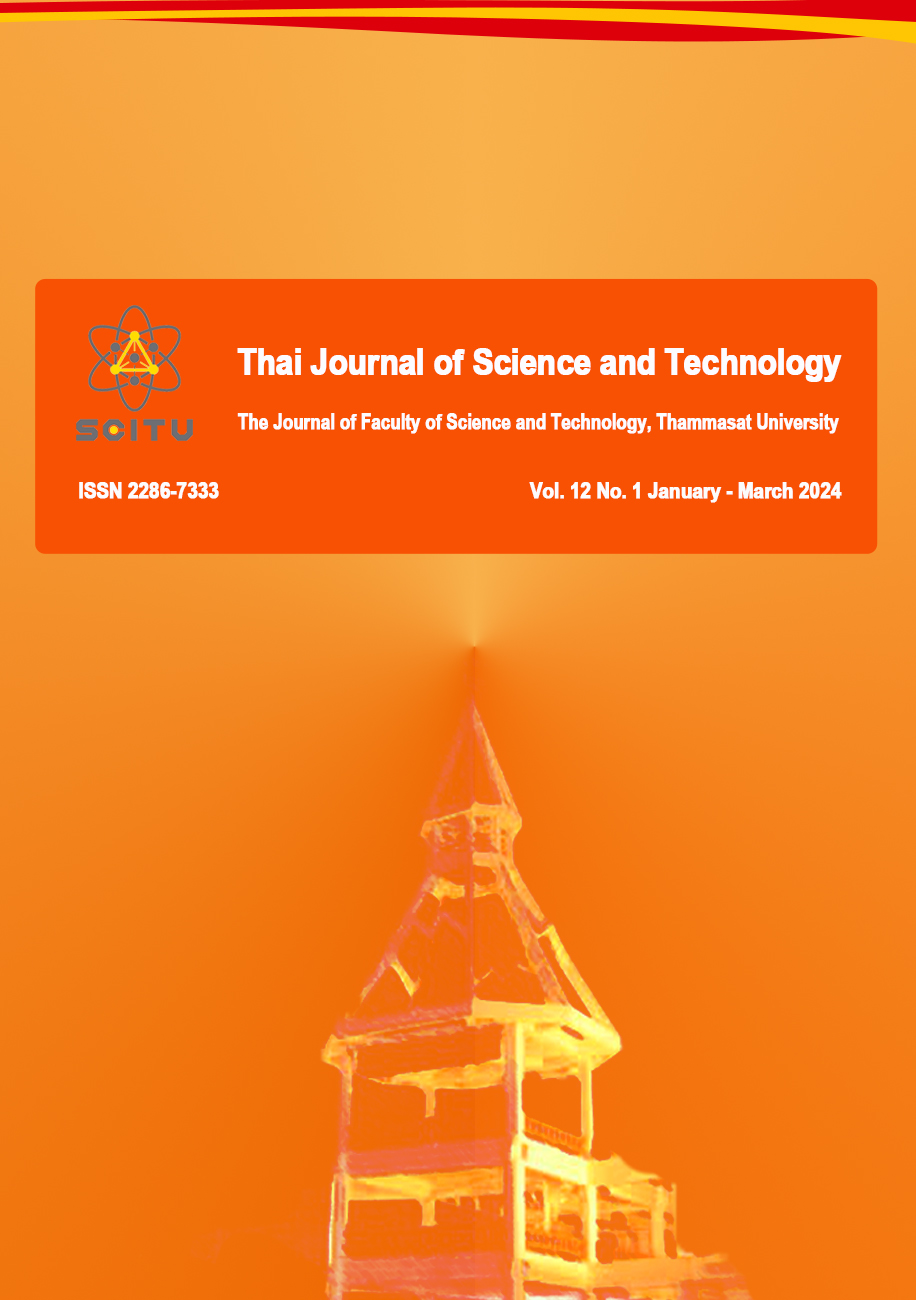Genetic Relationship Assessment of Apples Using HAT-RAPD Technique
Main Article Content
Abstract
High annealing temperature-random amplified polymorphic DNA (HAT-RAPD) technique was used for genetic relationship assessment of 14 apple samples that sold in Thailand. Thirty-one random primers out of seventy-two were successful for DNA amplification. Then 20 random primers which gave clear amplified products were selected for DNA fingerprinting. The result showed significant differences among 14 samples and also showed some bands in each sample. Moreover, this research found 3 random primers which tended to be DNA markers for apple identification. A dendrogram constructed based on polymorphic bands showed genetic similarities among apples and separated them into 3 clusters with similarity coefficients ranging from 0.57 to 0.86.
Article Details

This work is licensed under a Creative Commons Attribution-NonCommercial-NoDerivatives 4.0 International License.
บทความที่ได้รับการตีพิมพ์เป็นลิขสิทธิ์ของคณะวิทยาศาสตร์และเทคโนโลยี มหาวิทยาลัยธรรมศาสตร์ ข้อความที่ปรากฏในแต่ละเรื่องของวารสารเล่มนี้เป็นเพียงความเห็นส่วนตัวของผู้เขียน ไม่มีความเกี่ยวข้องกับคณะวิทยาศาสตร์และเทคโนโลยี หรือคณาจารย์ท่านอื่นในมหาวิทยาลัยธรรมศาสตร์ ผู้เขียนต้องยืนยันว่าความรับผิดชอบต่อทุกข้อความที่นำเสนอไว้ในบทความของตน หากมีข้อผิดพลาดหรือความไม่ถูกต้องใด ๆ
References
Buaban, S., Thanananta, T., & Thanananta, N. (2020). Genetic relationship assessment of Indigofera using HAT-RAPD technique. Thai Journal of Science and Technology, 9(3), 378-387.
Davey, M. W., & Keulemans, J. (2004). Determining the potential to breed for enhanced antioxidants status in Malus: Mean inter and intra varietal fruit vitamin C and glutathione contents at harvest and their evolution during storage. Journal of Agricultural and Food Chemistry, 52, 8031-8038.
Doyle, J. J., & Doyle, J. L. (1987). A rapid DNA isolation procedure for small quantities of fresh leaf tissue. Phytochem Bulletin, 19, 11-15.
Forte, A. V., Ignatov, A. N., Ponomarenko, V. V., Dorokhov D. B., & Savelyev, N. I. (2002). Phylogeny of the Malus (apple tree) species, inferred from the morphological traits and molecular DNA analysis. Russian Journal of Genetics, 38, 1150-1160.
Gao, Z. S., van de Weg, W. E., Schaart, J. G., Schouten, H. J., Tran, D. H., Kodde, L. P., van der Meer, I. M., van der Geest, A. H. M., Kodde, J., Breiteneder, H., Hoffmann-Sommergruber, K., Bosch, D., & Gilissen, L. J. W. J. (2005). Genomic cloning and linkage mapping of the Mal d 1 (PR-10) gene family in apple (Malus domestica). Theoretical and Applied Genetics, 111, 171-183.
Hemmat, M., Weeden, N. F., Manganaris, A. G., & Lawson, D. M. (1994). Molecular marker linkage map for apple. Journal of Heredity, 85, 4-11.
Korban, S. S., & Chen, H. (1992). Apple. In F. A. Hammerschlag & R. E. Litz (Eds.), Biotechnology of Perennial Fruit Crops (pp. 203-227). Wallingford: CAB International.
Korban, S. S. (1986). Interspecific hybridization in Malus. HortScience, 21(1), 41-48.
Lichtenthaler, R., & Marx, F. (2005). Total oxidant scavenging capacities of common European fruit and vegetable juices. Journal of Agricultural and Food Chemistry, 53, 103-110.
Maneenet, T., Thanananta, T., & Thanananta, N. (2017). Analysis of genetic relationship and identification of Dendrobium Section Callista using HAT-RAPD markers. Thai Journal of Science and Technology, 6(4), 316-323.
Meesangiem, T., Damrianant, S., Thanananta, T., & Thanananta, N. (2018). Genetic relationship among Paphiopedilum subgenus Brachypetalum section Brachypetalum using HAT-RAPD markers. Thai Journal of Science and Technology, 7(1), 99-105.
Phanroopthaw, J., Thanananta, T., & Thanananta, N. (2016). Genetic relationships between Dendrobium section Nigrohirsutae and their hybrids based on HAT-RAPD. Thai Journal of Science and Technology, 5(1), 77-87.
Raskin, I., & Ripoll, C. (2004). Can an apple a day keep the doctor away? Current Pharmaceutical Design, 10(27), 3419-3429.
Robinson, J. P., Harris, S. A., & Juniper, B. E. (2001). Taxonomy of the genus Malus Mill. (Rosaceae) with emphasis on the cultivated apple, Malus domestica Borkh. Plant Systematics and Evolution, 226, 35-58.
Rohlf, F. J. (2002). NTSYSpc Numerical Taxonomy and Multivariate Analysis System. New York: Applied Biostatistics, Inc.
Sambrook, J., Fritsch, E. F., & Maniatis, T. (1989). Molecular Cloning: A Laboratory Manual (2nd ed.). New York: Cold Spring Harbor Laboratory Press.
Singhsilarak, T., Thanananta, T., & Thanananta, N. (2018). Genetic relationship assessment and identification of durian using HAT-RAPD markers. Thai Journal of Science and Technology, 7(1), 89-98.
Suksakul, S., Thanananta, T., & Thanananta, N. (2018). Genetic relationship assessment and identification of Nymphaea sp. and their hybrids using HAT-RAPD. Thai Journal of Science and Technology, 7(4), 418-426.
Sun, H. H., Zhao, Y. O., & Li, C. M. (2012). Identification of markers linked to major gene loci involved in determination of fruit shape index of apples (Malus domestica). Euphytica, 185(2), 158-193.
Thanananta, N., Hongtongdee, P., & Thanananta, T. (2016). Identification and assessment of genetic relationship among Coelogyne (Orchidaceae) using HAT-RAPD. Thai Journal of Science and Technology, 5(1), 88-97.
Thanananta, N., Prasit, V., & Thannananta, T. (2012). Identification of rice cultivars KDML105 and its improved cultivars by using HAT-RAPD technique. Thai Journal of Science and Technology, 1(3), 169-179.
Thielen, C., Will, F., Zacharias, J., Dietrich, H., & Jacob, H. (2004). Polyphenols in apples: Distribution of polyphenols in apple tissue and comparison of fruit and juice. Deutsche Lebensmittel-Rundschau, 100(10), 389-398.
Williams, J. G., Kubelik, A. R., Livak, K. J., Rafalski, J. A., & Tingey, S. V. (1990). DNA polymorphisms amplified by arbitrary primers are useful as genetic markers. Nucleic Acids Research, 18(22), 6531-6535. doi: 10.1093/nar/18.22.6531.


